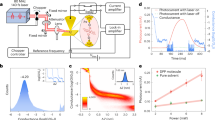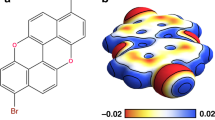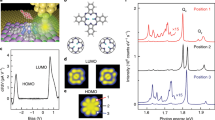Abstract
Attempts to resolve the energy-level structure of single DNA molecules by scanning tunnelling spectroscopy span over the past two decades, owing to the unique ability of this technique to probe the local density of states of objects deposited on a surface. Nevertheless, success was hindered by extreme technical difficulties in stable deposition and reproducibility. Here, by using scanning tunnelling spectroscopy at cryogenic temperature, we disclose the energy spectrum of poly(G)–poly(C) DNA molecules deposited on gold. The tunnelling current–voltage (I–V) characteristics and their derivative (dI/dV–V) curves at 78 K exhibit a clear gap and a peak structure around the gap. Limited fluctuations in the I–V curves are observed and statistically characterized. By means of ab initio density functional theory calculations, the character of the observed peaks is generally assigned to groups of orbitals originating from the different molecular components, namely the nucleobases, the backbone and the counterions.
This is a preview of subscription content, access via your institution
Access options
Subscribe to this journal
Receive 12 print issues and online access
$259.00 per year
only $21.58 per issue
Buy this article
- Purchase on Springer Link
- Instant access to full article PDF
Prices may be subject to local taxes which are calculated during checkout





Similar content being viewed by others
References
Ratner, M. A. Photochemistry: Electronic motion in DNA. Nature 397, 480–481 (1999).
Taubes, G. Biophysics: Double helix does chemistry at a distance—But how? Science 275, 1420–1421 (1997).
Porath, D., Bezryadin, A., de Vries, S. & Dekker, C. Direct measurement of electrical transport through DNA molecules. Nature 403, 635–638 (2000).
Porath, D., Cuniberti, G. & Di Felice, R. Charge transport in DNA-based devices. Topics Curr. Chem. 237, 183–227 (2004).
Endres, R. G., Cox, D. L. & Singh, R. R. P. Colloquium: The quest for high-conductance DNA. Rev. Mod. Phys. 76, 195–214 (2004).
Wiesendanger, R. Scanning Probe Microscopy and Spectroscopy (Cambridge Univ. Press, Cambridge, 1994).
Porath, D. & Millo, O. Single electron tunneling and level spectroscopy of isolated C60 molecules. J. Appl. Phys. 81, 2241–2244 (1997).
Porath, D., Levi, Y., Tarabiah, M. & Millo, O. Tunneling spectroscopy of isolated C60 molecules in the presence of charging effects. Phys. Rev. B 56, 9829–9833 (1997).
Huo, J. G. & Wang, K. D. Study of single molecules and their assemblies by scanning tunneling microscopy. Pure Appl. Chem. 78, 905–933 (2006).
Banin, U. & Millo, O. Tunneling and optical spectroscopy of semiconductor nanocrystals. Annu. Rev. Phys. Chem. 54, 465–492 (2003).
Binnig, G. & Rohrer, H. in Proc. 6th General Conf. of the European Physical Society, Trends in Physics Vol. 1 (eds Janta, J. & Pantoflicek, J.) 38 (European Physical Society, Prague, 1984).
Binnig, G. & Rohrer, H. Scanning tunneling microscopy—from birth to adolescence. Rev. Mod. Phys. 59, 615–625 (1987).
Shapir, E. et al. High-resolution STM imaging of novel poly(dG)-poly(dC) DNA. J. Phys. Chem. B 110, 4430–4433 (2006).
Lindsay, S. M., Thundat, T. & Nagahara, L. A. Adsorbate deformation as a contrast mechanism in STM images of bio-polymers in an aqueous environment: Images of the unstained, hydrated DNA double helix. J. Microsc. 152, 213–220 (1988).
Wilson, T. E. et al. Scanning tunneling microscopy at high gap resistances and on chemically modified silicon surfaces. J. Vac. Sci. Technol. B 9, 1171–1176 (1991).
Youngquist, M. G., Driscoll, R. J., Coley, T. R., Goddard, W. A. & Baldeschwieler, J. D. Scanning tunneling microscopy of DNA: Atom-resolved imaging, general observations and possible contrast mechanism. J. Vac. Sci. Technol. B 9, 1304–1308 (1991).
Tanaka, H. & Kawai, T. Visualization of detailed structures within DNA. Surf. Sci. 539, L531–L536 (2003).
Iijima, M. et al. STM/STS study of electron density of states at the bases sites in the DNA alternating copolymers. Chem. Lett. 34, 1084–1085 (2005).
Lindsay, S. M. et al. Studies of the electrical properties of large molecular adsorbates. J. Vac. Sci. Technol. B 9, 1096–1101 (1991).
Xu, M. S. et al. Conformation and local environment dependent conductance of DNA molecules. Small 1, 1–4 (2005).
Xu, M. S. et al. Conductance of single thiolated poly(GC)-poly(GC) DNA molecules. Appl. Phys. Lett. 87, 083902 (2005).
Clemmer, C. & Beebe, T. P. Graphite: A mimic for DNA and other biomolecules in scanning tunneling microscope studies. Science 251, 640–642 (1991).
de Pablo, P. J. et al. Absence of dc-conductivity in λ-DNA. Phys. Rev. Lett. 85, 4992–4995 (2000).
Gervasio, F. L., Carloni, P. & Parrinello, M. Electronic structure of wet DNA. Phys. Rev. Lett. 89, 108102 (2002).
York, D. M., Lee, T.-S. & Yang, W. Quantum mechanical treatment of biological macromolecules in solution using linear-scaling electronic structure methods. Phys. Rev. Lett. 80, 5011–5014 (1998).
Elhadj, S., Singh, G. & Saraf, R. F. Optical properties of an immobilized DNA monolayer from 255 to 700 nm. Langmuir 20, 5539–5543 (2004).
Barnes, N. R., Schreiner, A. F., Finnegan, M. G. & Johnson, M. K. Insight into externally bound 5,10,15,20-tetrakis(2-N-methylpyridyl)porphyrinatopalladium(II), PdP(2), with B-form DNA duplexes poly(G-C)2, poly(A-T)2, and CT DNA by using combined MCD, CD, and optical data. Biospectroscopy 4, 341–352 (1998).
Kotlyar, A. B., Borovok, N., Molotsky, T., Fadeev, L. & Gozin, M. In vitro synthesis of uniform poly(dG)–poly(dC) by Klenow exo- fragment of polymerase I. Nucleic Acids Res. 33, 525–535 (2005).
Cuniberti, G., Craco, L., Porath, D. & Dekker, C. Backbone-induced semiconducting behavior in short DNA wires. Phys. Rev. B 65, R241314 (2002).
Mehrez, H. & Anantram, M. P. Interbase electronic coupling for transport through DNA. Phys. Rev. B 71, 115405 (2005).
Hübsch, A., Endres, R. G., Cox, D. L. & Singh, R. R. P. Optical conductivity of wet DNA. Phys. Rev. Lett. 94, 178102 (2005).
Barnett, R. N. et al. Effect of base sequence and hydration on the electronic and hole transport properties of duplex DNA: Theory and experiment. J. Phys. Chem. A 107, 3525–3537 (2003).
Hanna, A. E. & Tinkham, M. Variation of the Coulomb staircase in a two-junction system by fractional electron charge. Phys. Rev. B 44, 5919–5922 (1991).
Millo, O. et al. Charging and quantum size effects in tunnelling and optical spectroscopy of CdSe nanorods. Nanotechnology 15, R1–R6 (2004).
Cavazzoni, C. & Chiarotti, G. L. A parallel and modular Car-Parrinello code. Comput. Phys. Commun. 123, 56–76 (1999).
Giannozzi, P., de Angelis, F. & Car, R. First-principle molecular dynamics with ultrasoft pseudopotentials: Parallel implementation and application to extended bioinorganic systems. J. Chem. Phys. 120, 5903–5915 (2004).
Perdew, J. P., Burke, K. & Ernzerhof, M. Generalized gradient approximation made simple. Phys. Rev. Lett. 77, 3865–3868 (1996).
Vanderbilt, D. Soft self-consistent pseudopotentials in a generalized eigenvalue formalism. Phys. Rev. B 41, 7892–7895 (1990).
Lu, X.-J. & Olson, W. K. 3DNA: A software package for the analysis, rebuilding and visualization of three-dimensional nucleic acid structures. Nucleic Acids Res. 311, 5108–5121 (2003).
Acknowledgements
We thank I. Brodsky, A. Migliore, M. Cavallari and O. Millo for fruitful discussions, and laboratory and computational help. Funding was provided by the EC through contracts IST-2001-38951 (‘DNA-Based Nanowires’) and FP6-029192 (‘DNA-Based Nanodevices’). Computer time was provided by CINECA (Bologna) and by INFM-CNR through National Supercomputing Projects.
Author information
Authors and Affiliations
Contributions
E.S. carried out all of the measurements, analysed the data and participated in writing the experimental paragraphs of the paper. H.C. collaborated in the set-up of the experiments and in the development of sample preparation. A.C. and C.C. carried out the calculations. A.C. participated in the analysis of the computational results. D.A.R. and G.C. participated in the theoretical interpretation. A.K. produced the poly(dG)–poly(dC) molecules. R.D.F. designed and guided the theoretical part and carried out the computational analysis and interpretation. D.P. designed and guided the whole work and in particular the experimental part and its analysis. R.D.F. and D.P. wrote the paper.
Corresponding authors
Supplementary information
Supplementary Information
Supplementary information (PDF 67 kb)
Rights and permissions
About this article
Cite this article
Shapir, E., Cohen, H., Calzolari, A. et al. Electronic structure of single DNA molecules resolved by transverse scanning tunnelling spectroscopy. Nature Mater 7, 68–74 (2008). https://doi.org/10.1038/nmat2060
Received:
Accepted:
Published:
Issue Date:
DOI: https://doi.org/10.1038/nmat2060
This article is cited by
-
Towards the ionizing radiation induced bond dissociation mechanism in oxygen, water, guanine and DNA fragmentation: a density functional theory simulation
Scientific Reports (2022)
-
Combined quantum tunnelling and dielectrophoretic trapping for molecular analysis at ultra-low analyte concentrations
Nature Communications (2021)
-
Construction and characterization of metal ion-containing DNA nanowires for synthetic biology and nanotechnology
Scientific Reports (2019)
-
Paving the way to single-molecule protein sequencing
Nature Nanotechnology (2018)
-
Electronic transport through tetrahedron-structured DNA-like system
Frontiers of Physics (2014)



